-
 Published: Nov 12, 2025
Published: Nov 12, 2025
-
 12 min. read
12 min. read
-
Summarize in ChatGPT
-
 Albert Dandy Velasquez
Albert Dandy Velasquez Content Specialist
Content Specialist
- Albert Dandy Velasquez blends SEO strategy with compelling storytelling to help businesses boost their visibility and revenue online. With a B.A. in English and certifications from HubSpot, Semrush, and Google Analytics, he has written and optimized hundreds of articles on organic SEO, content strategy, and user experience. He regularly contributes to the WebFX blog and SEO.com, creating content that helps readers turn marketing goals into measurable results. When he’s off the clock, he’s usually exploring new neighborhoods on two wheels, filming travel content, or chasing golden hour with a coffee in hand.
Table of Contents
- What is ChatGPT Atlas, and how does it work?
- What makes ChatGPT Atlas different?
- How to get started with ChatGPT Atlas?
- Is ChatGPT Atlas living up to the buzz? (what users are saying)
- The good (what users love)
- The bad (real pain points)
- The ugly (promising, but not ready for prime time?)
- ChatGPT Atlas vs. other AI browsers (how does it stack up?)
- AI browser comparison at a glance
- So, which one should you pick?
- The marketer’s playbook for AI browsers (what to do right now)
- 1. Structure content like AI reads (because it doesn’t read like humans)
- 2. Answer questions directly (not just target keywords)
- 3. Build topic clusters (not just individual pages)
- 4. Make forms and navigation AI-agent friendly
- 5. Add schema markup to key pages
- FAQs about ChatGPT Atlas and AI browsers
- Don’t get buried in AI search results. Stay discoverable with WebFX!
- What is ChatGPT Atlas and how does it work? ChatGPT Atlas is an AI browser developed by OpenAI that integrates ChatGPT directly into web browsing through a sidebar, allowing users to summarize content, compare products, and complete tasks without leaving the page—it’s built on Chromium and currently available for macOS users.
- How are users responding to ChatGPT Atlas? Early users praise the minimal, elegant interface and seamless sidebar integration, but significant issues include severe battery drain (1% every two minutes on MacBook), persistent upgrade prompts that feel pushy, and privacy concerns about browser memory features tracking user activity.
- How does ChatGPT Atlas compare to other AI browsers? Atlas offers supervised agent mode and privacy controls that competitors like Perplexity Comet (autonomous research focus), Microsoft Edge Copilot (integrated but less powerful), and The Browser Company’s Dia (ambient AI experience) don’t match—though each browser takes a unique approach to AI-assisted browsing.
- Why should marketers care about AI browsers? Generative AI traffic is growing 165× faster than organic search and converting 23% better, meaning marketers must shift from optimizing for page-one rankings to becoming sources that AI systems trust, surface, and cite in their responses.
- What are the key strategies for AI browser optimization? Marketers should structure content with clear headings and short paragraphs for AI parsing, answer conversational questions directly rather than stuffing keywords, build comprehensive topic clusters with internal linking, make forms AI-agent friendly, and implement schema markup (especially FAQ schema) on key pages.
TL;DR: Fast facts about ChatGPT Atlas
- ChatGPT meets browser: OpenAI’s Atlas integrates ChatGPT throughout your browsing experience, with sidebar assistance, optional memories, and an agent mode that completes tasks across websites.
- macOS launch, more platforms coming: Free for all ChatGPT users on Mac, with Windows, iOS, and Android “coming soon.” Agent mode requires a Plus, Pro, or Business subscription.
- Privacy-first design: Atlas gives full control over what ChatGPT can see, with site-by-site visibility toggles, incognito mode, and memory data retained for up to 30 days before automatic deletion.
Remember when “googling it” became synonymous with online search? We might be watching history repeat itself, but this time, the search bar comes with a built-in AI assistant.
On October 21, 2025, OpenAI launched ChatGPT Atlas, an AI browser that brings ChatGPT directly into your web browsing experience. Instead of jumping between your browser and ChatGPT to research products, summarize articles, or compare options, Atlas puts AI assistance right where you need it…in a sidebar!
But here’s the part that should make every marketer sit up: ChatGPT Atlas is not only changing how people browse. It’s also changing how online searchers find your brand, or more accurately, whether they find you at all. And if you’re not paying attention to this shift, you’re missing early signals about the future of search and your digital strategy.
Let’s get down to brass tacks and walk you through what ChatGPT Atlas actually is and does, how it compares to other AI browsers, and most importantly, what this means for your marketing strategy.
Here’s your roadmap:
- What is ChatGPT Atlas, and how does it work?
- Is ChatGPT Atlas living up to the buzz? (what users are saying)
- ChatGPT Atlas vs. other AI browsers (how does it stack up?)
- The marketer’s playbook for AI browsers (what to do right now)
Future-Proof Your SEO Strategy with OmniSEO®
Goodbye search engine optimization, hello search everywhere optimization.
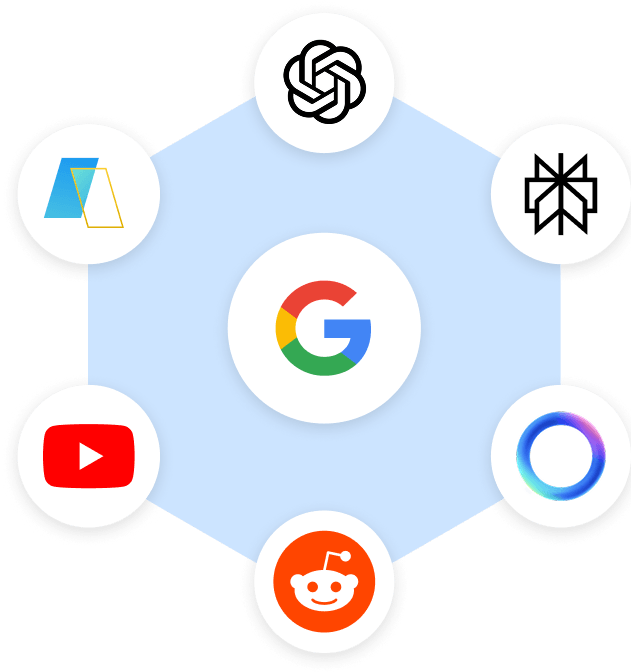
What is ChatGPT Atlas, and how does it work?
ChatGPT Atlas is an AI browser developed by OpenAI that integrates ChatGPT directly into your web browsing experience. Built on Chromium (the same open-source engine that powers Google Chrome), Atlas rolled out globally on macOS (for now) and is already available to Free, Plus, Pro, and Go users.
This OpenAI browser is also available in beta for Business and Enterprise/Edu users (if enabled by their plan admin). Versions for Windows, iOS, and Android are reported to be on the way.
What makes ChatGPT Atlas different?
- The ChatGPT sidebar: Click “Ask ChatGPT” on any webpage, and a sidebar opens that can see what you’re viewing. It summarizes content, compares products, analyzes data, and answers questions, all without leaving the page.
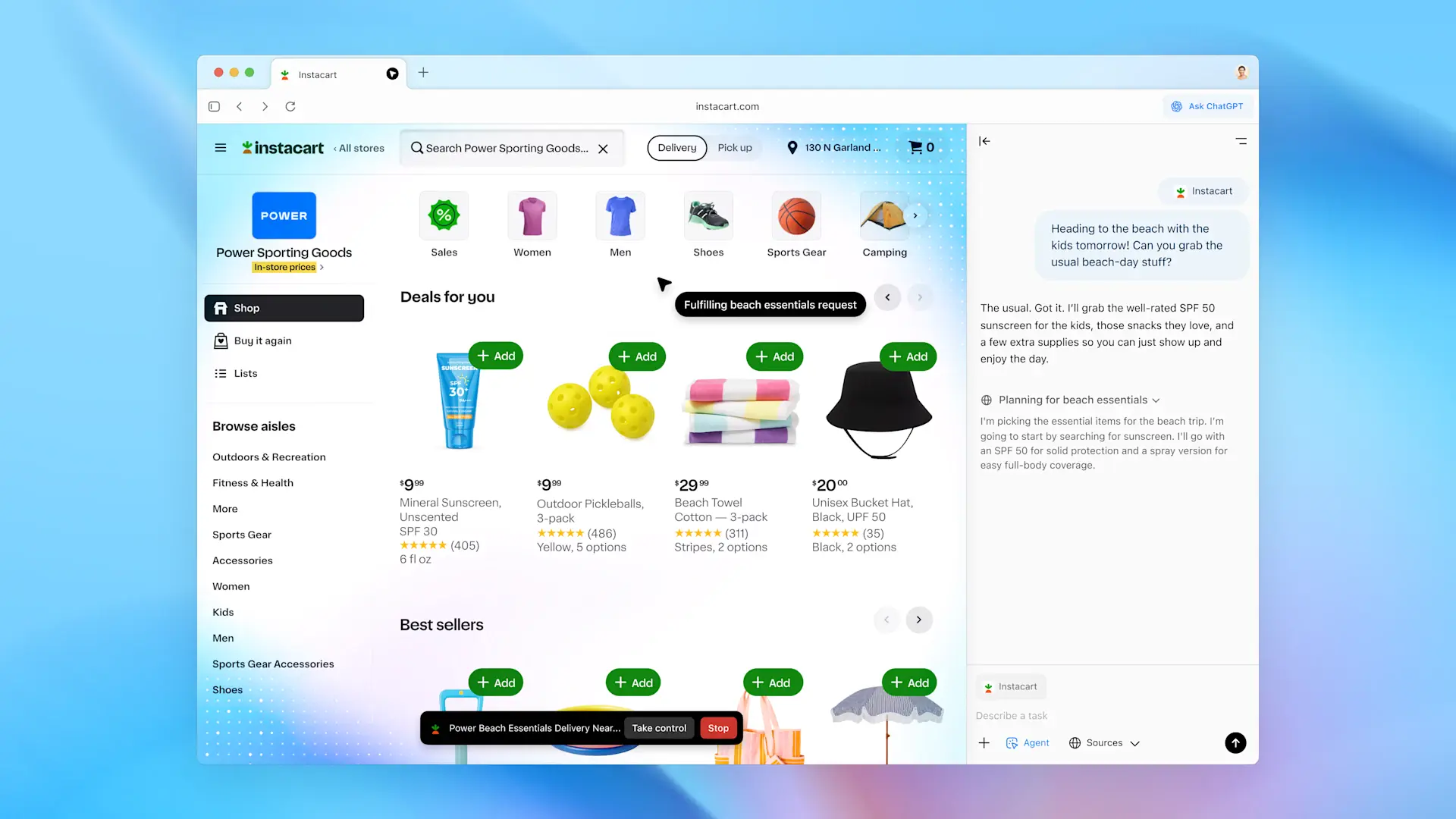
- Browser memories: Atlas can remember key details from sites you visit (with your permission), bringing that context back when you need it. Ask something like, “What were those running shoes I looked at last week?” and Atlas remembers.
- Agent mode (currently in preview): For Plus, Pro, and Business subscribers, Atlas includes agent mode, where ChatGPT actually interacts with websites for you. It can research vacation destinations, add items to shopping carts, compile information from multiple sources, and complete multi-step tasks while you supervise.
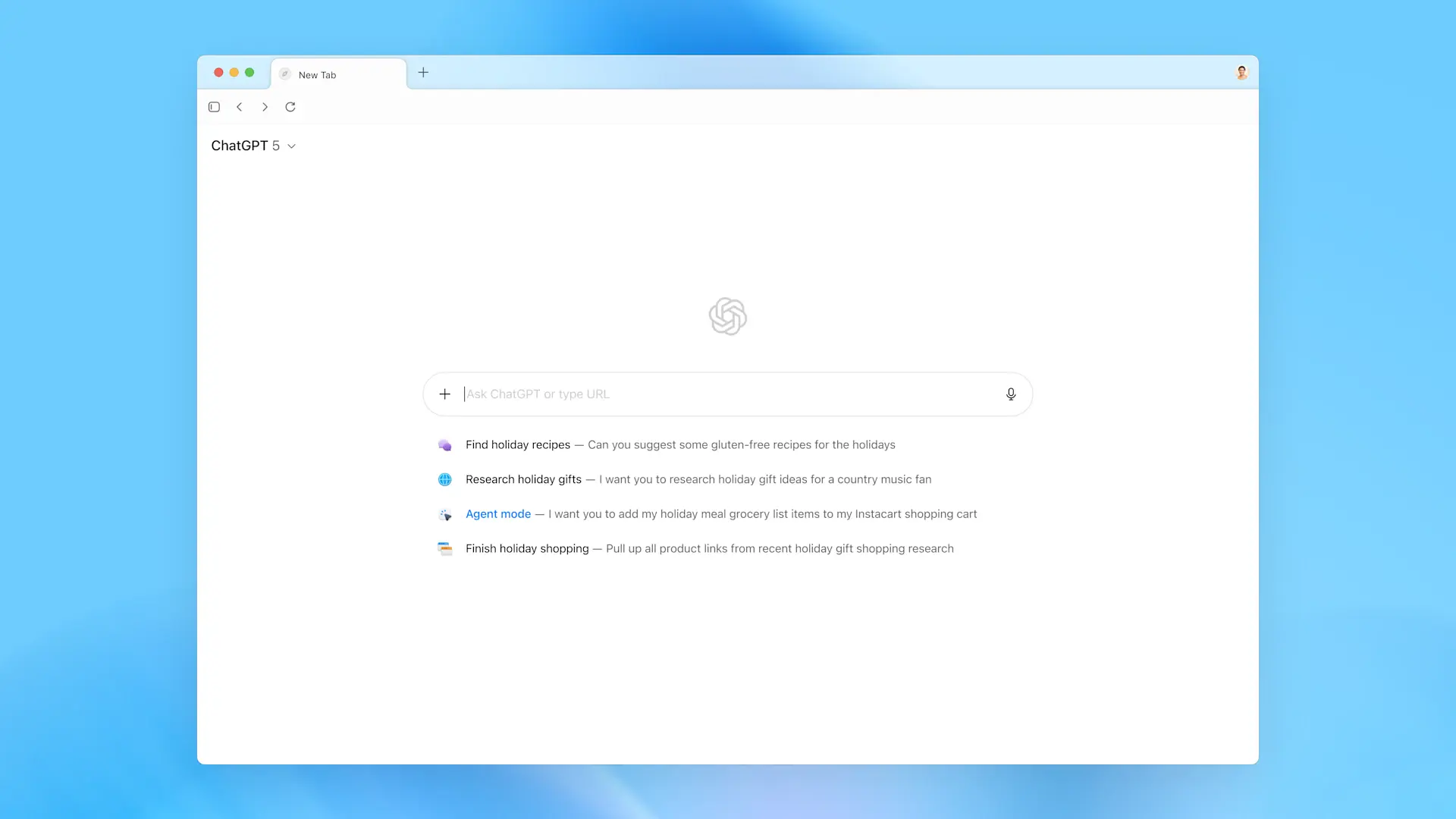
- Built-in cursor assistance: Highlight any text in emails, documents, or forms, and ChatGPT helps you rewrite, edit, or generate content inline. No more copying and pasting between tabs or apps.
- Privacy controls: You can decide what ChatGPT can see and remember. Clear specific pages or your entire browsing history, and use incognito to temporarily log out of ChatGPT. You can also turn site visibility on/off and manage or delete browser memories anytime.

- Data retention: Memory data is stored securely and retained for up to 30 days for safety monitoring before automatic deletion. OpenAI also deletes temporary content summaries within seven days. You can clear memories or browsing history manually anytime under Settings → Privacy & Safety.
- Pricing & access: The OpenAI browser operates on a freemium model. Free users get the core ChatGPT browser experience, while premium features like agent mode require a paid subscription (Plus, Pro, and Business).
How to get started with ChatGPT Atlas?
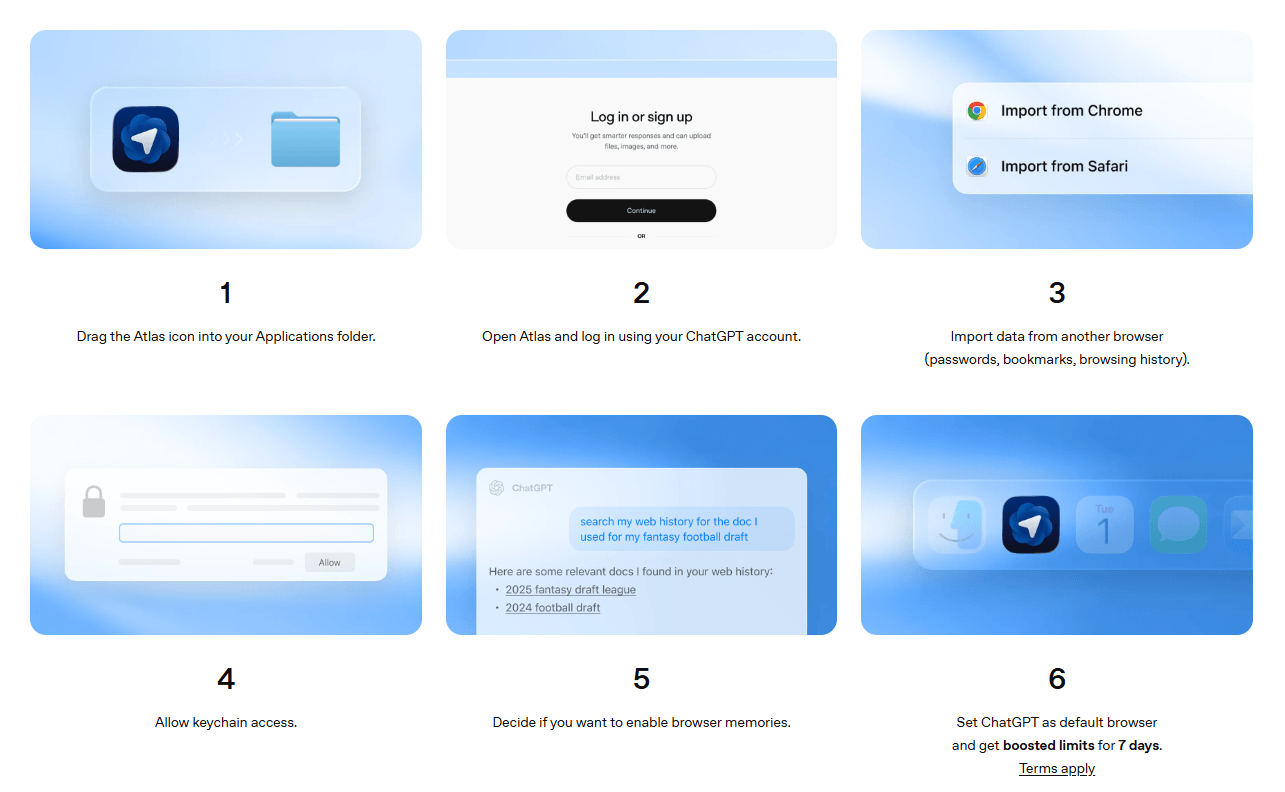
- Download ChatGPT Atlas for macOS. Grab the installer here.
- Drag Atlas to Applications. Move the app into your macOS Applications folder.
- Open Atlas and sign in. Log in using your ChatGPT account.
- Import your data. Bring over passwords, bookmarks, and browsing history from your current browser.
- Allow keychain access. Approve prompts so saved credentials work smoothly.
- Choose privacy settings. Decide if you want to enable browser memories (you can manage or clear them anytime).
- Optional: Set Atlas as default. If you make Atlas your default browser, you’ll get boosted limits for 7 days (terms apply).
Is ChatGPT Atlas living up to the buzz? (what users are saying)
ChatGPT Atlas launched with serious hype, but how’s it actually performing in the wild? We combed through user reviews, Reddit threads, and tech journals to get a pulse check of what people are really saying.
The verdict? Well, it’s complicated. Atlas shows genuine innovation in AI-assisted browsing, but it’s also revealing growing pains that come with being first out of the gate.
The good (what users love)
“It didn’t just feel nicer than the browser. It felt faster and calmer, like someone cleaned up the desk in my head.”
- A smoother, simpler browsing experience
Early testers describe Atlas as “super minimal, elegant, and more natural to use,” according to one reviewer on r/browsers. They noted how easy it is to switch between “old school search” and chat mode, a small but powerful detail that makes Atlas feel intuitive rather than experimental.
- The sidebar integration changes everything
The “Ask ChatGPT” sidebar eliminates context-switching. Users can say conversational commands like “Close all shopping tabs” or “Reopen that camera review I read yesterday,” and Atlas executes accurately. For researchers and content creators, this integration delivers genuine productivity gains. - Chrome extension compatibility smooths the transition
Since Atlas runs on Chromium, familiar Chrome extensions work without issues, lowering the barrier to switching. Users found success with tools like Tactiq and Loom, making Atlas viable for daily work without abandoning their existing toolkit.
The bad (real pain points)
“Atlas is… fine? But my big takeaway is that it’s pretty pointless for anyone not employed by OpenAI, and that Atlas is little more than cynicism masquerading as software.”
- Battery drain is a major issue
One Reddit user reported their MacBook battery dropped about 1% every two minutes while using the ChatGPT browser, a battery consumption rate that makes it impractical for mobile work. For a browser launching as macOS-only, this performance issue hits the core user base hard.
Comment
byu/E-Cockroach from discussion
inbrowsers
- Constant upgrade prompts feel pushy
Multiple reviewers mentioned feeling pressured to upgrade. A tester shared that after setting Atlas as the default browser, the “Make Default” prompt didn’t disappear, and it instantly flipped to a jarring “Upgrade” button. These persistent upsell attempts create friction rather than trust. - Privacy concerns loom large
Browser memories (the feature that lets Atlas remember your browsing context) trigger alarm bells for privacy-conscious users. An early adopter described it as “the extension of AI tentacles wrapping itself around the world.”
The ugly (promising, but not ready for prime time?)
“Atlas is a great tool for individuals who are already deep in the ChatGPT ecosystem… but in its current form, Atlas just isn’t ready for business.”
After reviewing dozens of user experiences, the reality is that ChatGPT Atlas represents an exciting glimpse of AI-native browsing, but it’s still in its infancy.
We’ve tried the OpenAI browser ourselves, and we personally think that if you’re a heavy ChatGPT user on macOS who does extensive research and content work, Atlas is worth testing. The sidebar integration alone could transform your workflow.
But for everyone else (especially mobile-first users, cross-platform teams, or anyone concerned about data privacy), it may be smarter to wait. Let OpenAI work through the growing pains, expand platform support, and build more trust around data handling before committing your daily browsing to Atlas.
ChatGPT Atlas vs. other AI browsers (how does it stack up?)
ChatGPT Atlas isn’t the only AI browser in town competing for your attention. Perplexity launched Comet earlier this year, Microsoft integrated Copilot Mode into Edge, and The Browser Company released Dia with a completely different approach to AI-assisted browsing.
Each browser takes a unique angle on integrating AI into your web experience, and understanding these differences matters if you’re optimizing content for AI-native discovery.
Here’s how the major players stack up:
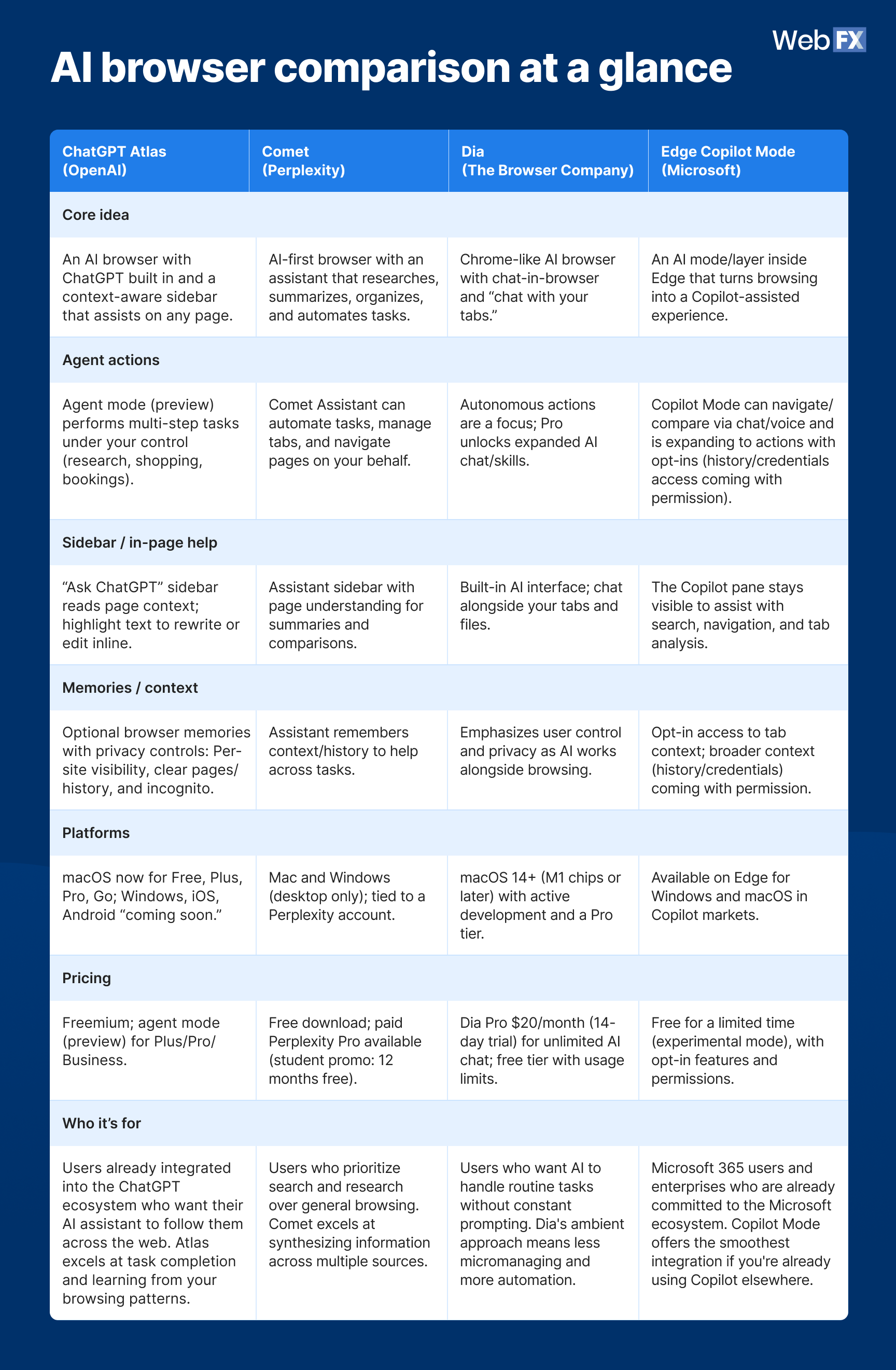
Source Data
AI browser comparison at a glance
|
Feature |
ChatGPT Atlas (OpenAI) | Comet (Perplexity) | Dia (The Browser Company) | Edge Copilot Mode (Microsoft) |
| Core idea | An AI browser with ChatGPT built in and a context-aware sidebar that assists on any page. | AI-first browser with an assistant that researches, summarizes, organizes, and automates tasks. | Chrome-like AI browser with chat-in-browser and “chat with your tabs.” | An AI mode/layer inside Edge that turns browsing into a Copilot-assisted experience. |
| Agent actions | Agent mode (preview) performs multi-step tasks under your control (research, shopping, bookings). | Comet Assistant can automate tasks, manage tabs, and navigate pages on your behalf. | Autonomous actions are a focus; Pro unlocks expanded AI chat/skills. | Copilot Mode can navigate/compare via chat/voice and is expanding to actions with opt-ins (history/credentials access coming with permission). |
| Sidebar / in-page help | “Ask ChatGPT” sidebar reads page context; highlight text to rewrite or edit inline. | Assistant sidebar with page understanding for summaries and comparisons. | Built-in AI interface; chat alongside your tabs and files. | The Copilot pane stays visible to assist with search, navigation, and tab analysis. |
| Memories / context | Optional browser memories with privacy controls: Per-site visibility, clear pages/history, and incognito. | Assistant remembers context/history to help across tasks. | Emphasizes user control and privacy as AI works alongside browsing. | Opt-in access to tab context; broader context (history/credentials) coming with permission. |
| Platforms | macOS now for Free, Plus, Pro, Go; Windows, iOS, Android “coming soon.” | Mac and Windows (desktop only); tied to a Perplexity account. | macOS 14+ (M1 chips or later) with active development and a Pro tier. | Available on Edge for Windows and macOS in Copilot markets. |
| Pricing | Freemium; agent mode (preview) for Plus/Pro/Business. | Free download; paid Perplexity Pro available (student promo: 12 months free). | Dia Pro $20/month (14-day trial) for unlimited AI chat; free tier with usage limits. | Free for a limited time (experimental mode), with opt-in features and permissions. |
| Who it’s for | Users already integrated into the ChatGPT ecosystem who want their AI assistant to follow them across the web. Atlas excels at task completion and learning from your browsing patterns. | Users who prioritize search and research over general browsing. Comet excels at synthesizing information across multiple sources. | Users who want AI to handle routine tasks without constant prompting. Dia’s ambient approach means less micromanaging and more automation. | Microsoft 365 users and enterprises who are already committed to the Microsoft ecosystem. Copilot Mode offers the smoothest integration if you’re already using Copilot elsewhere. |
So, which one should you pick?
Well, there’s clearly no single winner, and it highly depends on what you need.
Here’s our hot take: If you want the ChatGPT browser deeply integrated with privacy controls and a supervised agent, Atlas is the most cohesive pick today. Comet feels more “do-it-for-me” for research and workflow automation, Dia aims for an ambient AI experience with Chrome-like familiarity, and Edge’s Copilot Mode is a pragmatic middle ground inside a mainstream browser.
In practice, many teams pilot two AI browsers (let’s say Atlas + Comet) side by side for a month, then standardize on one while keeping the other for niche tasks.
The marketer’s playbook for AI browsers (what to do right now)
AI browsers aren’t replacing traditional search overnight, but they’re carving out a significant chunk of discovery traffic. In fact, it’s not surprising that Generative AI traffic is now growing 165× faster than organic search and converting 23% better. And with the birth of AI browsers, it’s only getting started.
With that, we can safely say SEO isn’t disappearing. It’s shifting, and so should your mindset, too. Instead of only optimizing for page-one rankings, marketers must optimize to become the source AI systems trust, surface, and cite.
Traditional SEO= Rank #1 on page 1
AI browser optimization= Become the source AI trusts
When someone asks ChatGPT Atlas or Perplexity Comet a question, these AI browsers synthesize answers from multiple sources. Your goal isn’t ranking position. It’s being selected as a trusted source in that answer. And if you want to get started today, here are five practical strategies that are proven to work:
1. Structure content like AI reads (because it doesn’t read like humans)
AI browsers scan for specific, extractable information. Dense paragraphs make this harder. Here is a simple action checklist:
- Use clear H2/H3 headings that answer specific questions
- Break content into short paragraphs (2-3 sentences max)
- Add bullet points for lists and key features
- Include FAQ sections with direct question-answer pairs
- Put your main answer in the first 100 words
Example transformation:
Before (AI-unfriendly)
“Our comprehensive email marketing solution provides businesses with advanced automation capabilities, detailed analytics dashboards, and segmentation tools that allow for highly targeted campaigns resulting in improved engagement metrics and ROI optimization across multiple channels.”
After (AI-friendly)
What makes good email marketing software?
Look for three core features:
- Automation: Schedule campaigns and trigger emails based on user behavior
- Analytics: Track open rates, clicks, and conversions in real-time
- Segmentation: Target specific audience groups with personalized content
Most businesses see 3-5x better engagement with segmented campaigns.
2. Answer questions directly (not just target keywords)
AI browsers respond to conversational queries, not keyword strings. Follow this Keyword → Question Framework:

Source Data
| Old keyword focus | New question focus | Content approach |
| “B2B lead generation” | “How do B2B companies get qualified leads?” | Start with: “Most B2B companies generate qualified leads through…” |
| “CRM software pricing” | “What should I budget for CRM software?” | Start with: “Plan to spend $50-150 per user monthly for…” |
| “email open rates” | “What’s a good email open rate?” | Start with: “Industry average open rates range from 15-25%…” |
Write like you’re answering a colleague’s question, not stuffing keywords into sentences.
3. Build topic clusters (not just individual pages)
AI browsers favor comprehensive coverage over thin content. Try implementing this topic cluster approach:
Create one pillar page (comprehensive guide on your main topic) + 3-5 supporting articles covering specific angles + internal links connecting everything.
Here’s an example for “marketing automation”:
- Pillar: Complete Guide to Marketing Automation (3,000+ words)
- Cluster 1: Best Marketing Automation Tools Compared
- Cluster 2: Email Automation Workflows That Convert
- Cluster 3: Marketing Automation for Small Teams
- Cluster 4: Integrating Your CRM with Email Automation
- Cluster 5: Marketing Automation Metrics That Matter
Link everything together with contextual internal links. Update regularly.
4. Make forms and navigation AI-agent friendly
As AI browsers get agentic capabilities (completing tasks for users), your site needs to work with automated interactions. Here are some quick wins to follow:

Do these:
- Use clear button text (“Get Your Free Quote” not “Learn More”)
- Label form fields properly (“Email Address” not just “Email”)
- Keep navigation consistent across pages
- Minimize pop-ups that block content

Avoid these:
- Vague calls-to-action
- Required logins to view basic info
- Complex multi-step processes for simple actions
- Auto-playing videos
Ask yourself, “Could someone verbally walk through this process over the phone?” If yes, it’s probably agent-friendly.
5. Add schema markup to key pages
LLMs won’t cite what they can’t parse. Structured data is how you can speak machine, and schema is proven to help AI understand what your content is about. Start with these high-impact types:

Source Data
| Page type | Schema to add | Why it matters |
| Service pages | FAQPage | AI browsers love direct Q&A pairs |
| How-to content | HowTo | Perfect for task-based queries |
| Product pages | Product | Helps AI compare features/pricing |
| Blog posts | Article | Clarifies topic and content type |
Start with the FAQ schema as it’s the easiest to implement and delivers immediate results.
FAQs about ChatGPT Atlas and AI browsers
Is ChatGPT Atlas free to use?
Yes, ChatGPT Atlas is free to download and use for all ChatGPT account holders (Free, Plus, Pro, and Go users). However, advanced features like agent mode (which lets ChatGPT complete multi-step tasks for you) require a Plus, Pro, or Business subscription. The core browsing experience, ChatGPT sidebar, and basic browser memories are available to free users.
Can ChatGPT Atlas replace Chrome as my main browser?
Not yet for most users. While Atlas offers innovative AI integration, it’s currently macOS-only with no mobile support. If you’re a heavy ChatGPT user on a Mac who does extensive research or content work, Atlas could become your primary browser. But for cross-platform teams, mobile-first users, or anyone needing Chrome’s mature extension ecosystem and account switching, Chrome remains the more practical choice.
Is ChatGPT Atlas safe? What about my browsing data?
Atlas includes privacy controls that let you manage what ChatGPT can see and remember. You can turn site visibility on or off per website, clear browsing history (which deletes associated browser memories), and use incognito mode to browse without ChatGPT tracking. Browser memories are optional and stored for 30 days before automatic deletion.
What’s the difference between ChatGPT Atlas and regular ChatGPT?
ChatGPT Atlas is a full web browser with ChatGPT integrated throughout, while regular ChatGPT is a standalone chat interface. In Atlas, ChatGPT can see the pages you’re viewing, remember details from your browsing history (if enabled), and complete tasks across multiple websites through agent mode.
You can ask Atlas to “find the apartments I looked at last week” or “compare these three products and add the best one to my cart” (actions impossible in standard ChatGPT). Think of Atlas as ChatGPT that follows you across the entire web rather than living in a single tab.
Does ChatGPT Atlas work on Windows or mobile devices?
Not yet. ChatGPT Atlas launched exclusively for macOS in October 2025. OpenAI has confirmed that Windows, iOS, and Android versions are “coming soon,” but hasn’t announced specific release dates.
If you need AI-assisted browsing on other platforms, alternatives like Microsoft’s Copilot Mode (built into Edge for Windows) or Perplexity’s Comet (cross-platform) might better fit your needs until Atlas expands platform support.
How does agent mode actually work in ChatGPT Atlas?
Agent mode allows ChatGPT to interact with websites on your behalf, like opening tabs, clicking buttons, filling forms, and completing multi-step tasks while you supervise. For example, you could ask it to “research Italian restaurants near me, compare menus and prices, and add a reservation to my calendar.”
Agent mode is currently in preview for Plus, Pro, and Business subscribers. It has limitations, though: It can’t download files, install extensions, access your file system, or run code. It also pauses on sensitive sites like banks to get your explicit permission before proceeding.
What is an AI browser, and how does it differ from a traditional web browser?
An AI browser like ChatGPT Atlas integrates a built-in large language model (LLM) or assistant sidebar that can summarize content, answer questions, and perform tasks while you browse. In contrast, traditional browsers display search results and links for users to click through. With an AI browser, the goal shifts from “click to visit” to “ask and get an answer”.
Will AI browsers replace Google?
Not anytime soon. Google still dominates with nearly 90% of the global search market share, and that’s not disappearing overnight. AI browsers like ChatGPT Atlas, Perplexity Comet, and others are capturing a specific slice of search behavior, users who want comprehensive answers, comparison shopping, and task completion without clicking through multiple sites.
It would be more of a channel expansion, not a replacement. Traditional search engines excel at navigational queries and broad discovery. AI browsers shine for complex research, multi-step tasks, and conversational queries where users want synthesized answers rather than a list of links.
How can marketers optimize their websites for AI browsers like ChatGPT Atlas?
To show up in AI browsers, your website needs to be clear, actionable, and structured in a way that browsers not only read but also interact with. Here are the three highest-impact moves to do right now:
- Write for extraction, not just reading:
- Use H2/H3 headings that answer direct questions.
- Break paragraphs into 2–3 sentences max.
- Lead with your answer in the first 100 words.
- Use bullet lists, tables, and clear definitions.
- Make your site agent-friendly:
- CTAs like “Request a Quote” or “Book Demo” beat vague ones.
- Label form fields explicitly (“Email Address,” “Phone Number”).
- Avoid gated info, complex flows, and pop-ups that block content.
- Speak machine-readable with schema:
- Add FAQPage markup to your FAQs.
- Use HowTo schema for task-type content.
- Use Product schema for comparisons and specs.
Meet WebFX
Book a discovery call with us today to discuss how digital marketing expertise can be the driving force behind your success!

Don’t get buried in AI search results. Stay discoverable with WebFX!
AI browsers aren’t some distant future concept. They’re live, they’re growing, and they’re changing how millions of people now discover content online.
ChatGPT Atlas marks the first wave of this fundamental shift, and the brands that know how to adapt now are actually shaping how AI systems learn to cite, trust, and recommend sources. And those who don’t? They get buried in AI search results.
That’s the edge WebFX gives you.
With 29 years of digital expertise and a team of 750+ experts, we’re leading the charge in generative engine optimization (GEO), helping businesses like yours earn visibility, citations, and revenue across AI search, not just Google.
Start earning your spot in AI results today. Contact us online or call 888-601-5359 to speak with a strategist today about how our high-impact GEO services can future-proof your brand for AI-powered discovery.
-
 Albert Dandy Velasquez blends SEO strategy with compelling storytelling to help businesses boost their visibility and revenue online. With a B.A. in English and certifications from HubSpot, Semrush, and Google Analytics, he has written and optimized hundreds of articles on organic SEO, content strategy, and user experience. He regularly contributes to the WebFX blog and SEO.com, creating content that helps readers turn marketing goals into measurable results. When he’s off the clock, he’s usually exploring new neighborhoods on two wheels, filming travel content, or chasing golden hour with a coffee in hand.
Albert Dandy Velasquez blends SEO strategy with compelling storytelling to help businesses boost their visibility and revenue online. With a B.A. in English and certifications from HubSpot, Semrush, and Google Analytics, he has written and optimized hundreds of articles on organic SEO, content strategy, and user experience. He regularly contributes to the WebFX blog and SEO.com, creating content that helps readers turn marketing goals into measurable results. When he’s off the clock, he’s usually exploring new neighborhoods on two wheels, filming travel content, or chasing golden hour with a coffee in hand. -

WebFX is a full-service marketing agency with 1,100+ client reviews and a 4.9-star rating on Clutch! Find out how our expert team and revenue-accelerating tech can drive results for you! Learn more
Try our free Marketing Calculator
Craft a tailored online marketing strategy! Utilize our free Internet marketing calculator for a custom plan based on your location, reach, timeframe, and budget.
Plan Your Marketing Budget
Table of Contents
- What is ChatGPT Atlas, and how does it work?
- What makes ChatGPT Atlas different?
- How to get started with ChatGPT Atlas?
- Is ChatGPT Atlas living up to the buzz? (what users are saying)
- The good (what users love)
- The bad (real pain points)
- The ugly (promising, but not ready for prime time?)
- ChatGPT Atlas vs. other AI browsers (how does it stack up?)
- AI browser comparison at a glance
- So, which one should you pick?
- The marketer’s playbook for AI browsers (what to do right now)
- 1. Structure content like AI reads (because it doesn’t read like humans)
- 2. Answer questions directly (not just target keywords)
- 3. Build topic clusters (not just individual pages)
- 4. Make forms and navigation AI-agent friendly
- 5. Add schema markup to key pages
- FAQs about ChatGPT Atlas and AI browsers
- Don’t get buried in AI search results. Stay discoverable with WebFX!
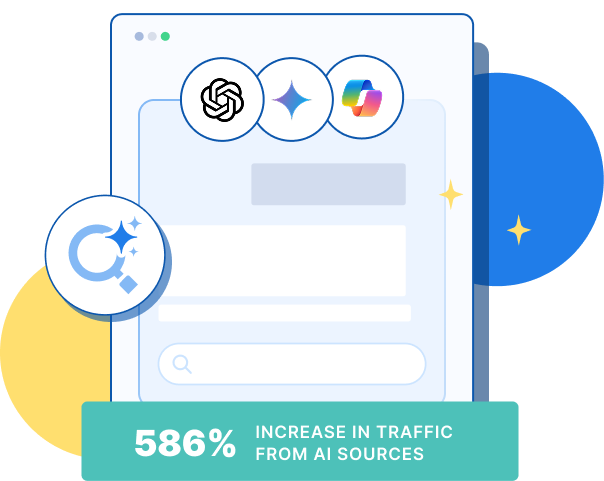
See AI Marketing in Action
Explore how WebFX helped a regional brand get discovered in AI search experiences — proving what’s possible with today’s AI-driven marketing!

Proven Marketing Strategies
Try our free Marketing Calculator
Craft a tailored online marketing strategy! Utilize our free Internet marketing calculator for a custom plan based on your location, reach, timeframe, and budget.
Plan Your Marketing Budget
What to read next




